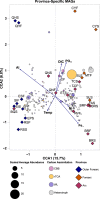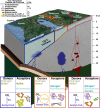Chemolithoautotroph distributions across the subsurface of a convergent margin
- PMID: 36257972
- PMCID: PMC9751116
- DOI: 10.1038/s41396-022-01331-7
Chemolithoautotroph distributions across the subsurface of a convergent margin
Abstract
Subducting oceanic crusts release fluids rich in biologically relevant compounds into the overriding plate, fueling subsurface chemolithoautotrophic ecosystems. To understand the impact of subsurface geochemistry on microbial communities, we collected fluid and sediments from 14 natural springs across a ~200 km transect across the Costa Rican convergent margin and performed shotgun metagenomics. The resulting 404 metagenome-assembled genomes (MAGs) cluster into geologically distinct regions based on MAG abundance patterns: outer forearc-only (25% of total relative abundance), forearc/arc-only (38% of total relative abundance), and delocalized (37% of total relative abundance) clusters. In the outer forearc, Thermodesulfovibrionia, Candidatus Bipolaricaulia, and Firmicutes have hydrogenotrophic sulfate reduction and Wood-Ljungdahl (WL) carbon fixation pathways. In the forearc/arc, Anaerolineae, Ca. Bipolaricaulia, and Thermodesulfovibrionia have sulfur oxidation, nitrogen cycling, microaerophilic respiration, and WL, while Aquificae have aerobic sulfur oxidation and reverse tricarboxylic acid carbon fixation pathway. Transformation-based canonical correspondence analysis shows that MAG distribution corresponds to concentrations of aluminum, iron, nickel, dissolved inorganic carbon, and phosphate. While delocalized MAGs appear surface-derived, the subsurface chemolithoautotrophic, metabolic, and taxonomic landscape varies by the availability of minerals/metals and volcanically derived inorganic carbon. However, the WL pathway persists across all samples, suggesting that this versatile, energy-efficient carbon fixation pathway helps shape convergent margin subsurface ecosystems.
© 2022. The Author(s), under exclusive licence to International Society for Microbial Ecology.
Conflict of interest statement
The authors declare no competing interests.
Figures






References
-
- Harris RN, Wang K. Thermal models of the middle America trench at the Nicoya Peninsula, Costa Rica. Geophys Res Lett. 2002;29:6–1. doi: 10.1029/2002GL015406. - DOI
Publication types
MeSH terms
Substances
LinkOut - more resources
Full Text Sources
Research Materials

